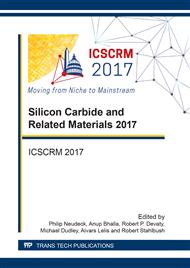p.43
p.47
p.51
p.55
p.60
p.67
p.72
p.76
p.80
Suppression of Polytype Transformation with Extremely Low-Dislocation-Density 4H-SiC Crystal in Two-Step Solution Method
Abstract:
We achieved the growth of extremely-high quality SiC crystal with two-step solution method with specially-designed seed crystals. The two-step growth consists of 1st step growth on Si-face for the reduction of threading dislocations and 2nd step growth on C-face for the reduction of basal plane dislocations and thickening. In this method, we can make the dislocation density extremely low, while the polytype easily changes during growth due to the absence of spiral hillocks originating from threading screw dislocation (TSD). In this study, we prepared specially designed seed crystals for both 1st and 2nd growth steps to provide steps continuously. In the seeds, a few TSDs exist at the upper-side of the step structure. Consequently, we demonstrated the suppression of the polytype transformation during the C-face growth with extremely low-dislocation-density crystal. Accordingly, we successfully obtained extremely low-dislocation density 4H-SiC with TSD, TED and BPD density of 11, 385 and 28 cm-2.
Info:
Periodical:
Pages:
60-63
Citation:
Online since:
June 2018
Authors:
Price:
Сopyright:
© 2018 Trans Tech Publications Ltd. All Rights Reserved
Share:
Citation:


